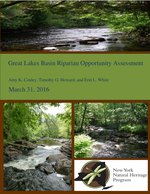Great Lakes Basin Riparian Opportunity Assessment
Project Sponsor: New York State Department of Environmental Conservation - Division of Lands and Forests
End Date: June 30, 2016
Summary
We will provide the DEC’s Great Lakes Program with a riparian land inventory and opportunity assessment to strategically identify and prioritize sites for implementation of DEC’s Trees for Tribs program and other riparian restoration efforts within New York’s Great Lakes basin. The primary goal of this assessment is to identify target locations where enhancement of riparian buffers will produce tangible benefits by improving water quality (reduction of nutrient and sediment loading, erosion control, etc.) and habitat quality (riparian cover, habitat connectivity, etc.). A secondary goal of this assessment is the identification of opportunities for riparian protection, including conservation easements and land acquisition.
These products are dated 2016. Please refer to the Statewide Riparian Opportunity Assessment products, completed January 2018, for updated products for the Great Lakes Basin and all other basins in NY.
Project Summary
The Great Lakes Basin Riparian Opportunity Assessment (aka Great Lakes Trees for Tribs) began April 1, 2015 and spanned one year. The New York Natural Heritage Program (NYNHP) of the State University of New York College of Environmental Science and Forestry (ESF) completed this project for the New York State Department of Environmental Conservation’s (NYS DEC) Great Lakes Watershed Program. The goal of the project was to support strategic identification and prioritization of sites for implementation in DEC’s Trees for Tribs program, which enlists the help of volunteers to plant native trees and shrubs in riparian buffers of streams to improve wildlife habitat, water quality, climate resiliency, and to provide flood protection during storm events. While this was the primary goal of our assessment, we maintained additional goals of riparian protection as well as other restoration efforts. This assessment directly supports multiple goals and actions included in New York’s Interim Great Lakes Action Agenda and advances an ecosystem-based management approach to riparian restoration and protection work in the Basin by promoting strategic, science-based decision-making to achieve multiple benefits.
NY Natural Heritage Program staff on the project included Amy Conley, Spatial Ecologist, Tim Howard, Director of Science, and Erin White, Zoologist. The project steering committee was made up of the NYS DEC's Great Lakes Program, Division of Water, Division of Lands and Forests, and Division of Fish and Wildlife. In addition, there was representation from The Nature Conservancy Central/Western NY Chapter, NYS Soil & Water Conservation Committee, the NYS Department of Agriculture and Markets, and additional staff from ESF. The Steering Committee met at regular intervals throughout the project to provide feedback on the following tasks:
Project Development
Task 1: Develop and Document a Proposed Assessment Methodology
The Steering Committee met in June to review our recommended methods. We compiled feedback and revised this to produce our working Assessment Methodology (PDF, 425.3 KB) to be used in later tasks. Full descriptions of our proposed habitat indicators, methods for identifying riparian habitat, critical zone and location analysis, and site prioritization can be found in this document.
Task 2: Identify Sub-Watersheds (or HUC 12 Hydrologic Units) for Water Quality and Habitat Quality Management
Identify Sub-Watersheds (or HUC 12 Hydrologic Units) for Water Quality and Habitat Quality Management. For this task, we created health indicator scores, stress indicator scores, as well as an overall comprehensive score for each sub-watershed in the Great Lakes Basin.
Deliverable 1: PDF of Summary Results
Critical Zones (Sub-Watersheds) (PDF, 76.3 MB) contains further details and draft results for this task. The steering committee met to review this product in October 2015.
Deliverable 2: Geodatabase Data
The full data set, including polygons for all 687 sub-watersheds in the Great Lakes Basin, and an attribute table that includes raw and normalized scores for all indicators, can be found in an ArcGIS feature class inside the critical zone data (sub-watershed scores) geodatabase (ZIP, 8.5 MB).
Task 3: Identify Locations (Catchments) Within the Sub-Watersheds Where Trees for Tribs Can Have a Tangible Effect on Improving Water Quality and Habitat Quality Management
For the most part, the same suite of indicators and methods of scoring that were used to classify sub-watersheds, were used to classify catchments within the sub-watersheds, with improvements suggested by the steering committee during review of our critical zone analysis.
Deliverable 1: Summary Results
Results for this task are include separate maps for each sub-region in the basin: Critical Locations (ZIP, 423.3 MB).
Deliverable 2: Geodatabase Data
The full data set, which contains the catchment polygons for the entire study area, and an attribute table that includes raw and normalized scores for all indicators, can be found in an ArcGIS feature class inside the critical location data (catchment scores) geodatabase (ZIP, 26.4 MB) (12/31/2015).
Task 4: Prioritize Locations
We prioritized these locations (with assistance from the steering committee), and compiled this information in a final digital report and map book.
Completed Products

This task was completed on March 31, 2016 and a final report and final products can be found here.
Dec. 10, 2020 | Updated Feb. 11, 2021, 7:40 p.m.